
malkovru_esperanton_en - копия
.pdf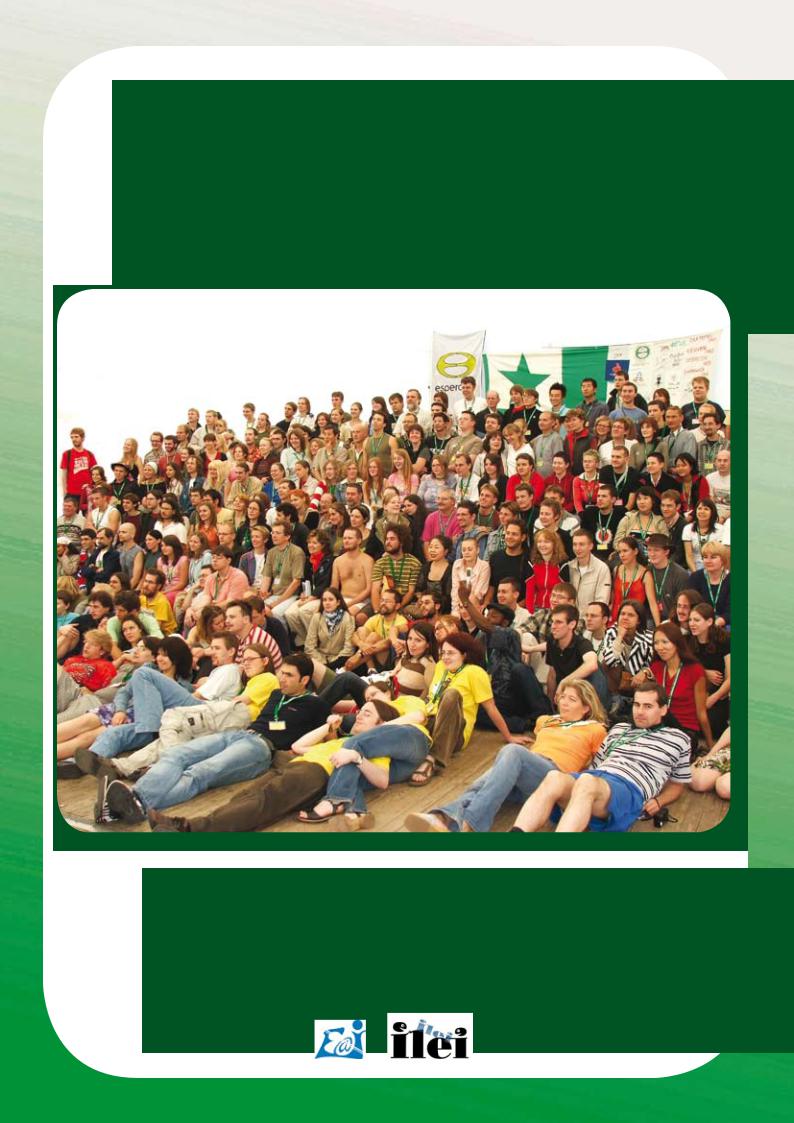
Discover esperanto
a fascinating language
www.ikso.net

Contents
Contents |
|
Basic information about Esperanto.......................................................................................................... |
03 |
Introducing the Esperanto language........................................................................................................ |
10 |
Personal stories about Esperanto............................................................................................................. |
12 |
Zamenhof, Esperanto's founder................................................................................................................ |
17 |
The psychology of Esperanto..................................................................................................................... |
19 |
Frequently asked questions about Esperanto......................................................................................... |
21 |
Local information about Esperanto......................................................................................................... |
23 |
Dear reader,
Have you ever wanted to tell someone about a good movie, an interesting book, or something else you like? That's why we want to tell you about Esperanto. We're fans of the language, so we'd like other people to know about it too and discover how good it is for international communication.
"We" are people from various countries who regularly use Esperanto to connect across national borders. We're also active in the organizations that collaborated to produce this booklet: E@I and ILEI, both described on page 7.
The booklet has seven sections. We start with some basic information about Esperanto. Then there's a quick introduction to the language itself. The third section contains the personal stories of some Esperanto speakers. The fourth part briefly describes the work of L. L. Zamenhof, the man who gave Esperanto its basic structure. In the fifth section, a psychologist discusses Esperanto and international communication from a psychological angle. Then we answer some frequently asked questions about Esperanto. And we end with some details of the Esperanto movement in English-speaking countries.
As we've said, we're fans of Esperanto, and if this booklet piques your interest in this fascinating language, we'll be delighted.
Happy reading! |
The E@I team |
PS: After reading this booklet, you may like to read some news about Esperanto.
If so, take a look at www.aktuale.info.
This booklet has been translated from the original Esperanto version. Design and format: Stano Marček.
You can freely download this booklet in more languages at www.ikso.net/broshuro. This booklet may be copied, distributed, and used for non-commercial purposes, provided that it is copied without changes and includes this copyright text. Any other use of the contents can only be made with the permission of E@I and ILEI. You can contact us about this at the following address: broshuro@ikso.net.

Basic information about Esperanto
Esperanto is a language, just like other human languages. You can express feelings and thoughts in Esperanto the same way as in other languages. You can sing songs in Esperanto, write poetry, quarrel, fall in love, gossip, tell jokes, play games, console a friend, have a scientific discussion, and so on and so forth.
People don't just speak Esperanto, they write it too. Here are some examples:
Esperanto estas lingvo. (Esperanto is a language.)
Ni havas revon. (We have a dream.)
La suno brilas. (The sun is shining.)
Ĉu vi vidas min? (Do you see me?)
Jes, mi vidas vin. (Yes, I see you.)
Mi amas vin! (I love you!)
National and ethnic languages belong to specific groups of people. For example, Hungarian belongs to the Hungarians, Portuguese belongs to the Brazilians and the Portuguese, Japanese belongs to the Japanese, and so on.
It's different with Esperanto. Esperanto doesn't belong to any particular nation or people – it belongs to everyone who has learned it, regardless of where they come from or where they live. Esperanto is not a national language, but an international language with speakers in every part of the world.
Esperanto'smainaimistosimplifycontactandcommunication between people who don't share a native or national language. In our experience, the Esperanto language is particularly suitable for use in global communication by "ordinary people" who have an interest in other countries and cultures.
"For me, Esperanto is a wonderful language for keeping in touch with friends in many countries and for working on
international projects."
Peter Baláž coordinator of E@I
Esperanto's basic structure was designed by one man, L. L. Zamenhof. He created it with great care and imagination, drawing his inspiration from national languages. It took him about ten years. Only when he felt that the language had acquired its own "spirit" did he deem it ready to be presented to the general public. That happened in 1887 with the publication of a booklet called Lingvo Internacia (International Language).
In his booklet, Zamenhof used the pseudonym Doktoro Esperanto (Doctor Hoping), but the word Esperanto later became the name of the language itself. In the following years, the booklet circulated among language enthusiasts and idealists in many countries who learned the language and began using it for global communication. That's how Esperanto evolved,
little by little, from one man's |
|
|
|
|
|
project into a living international |
|
|
|
|
|
language. Today, Esperanto is |
|
|
|
|
|
used and admired by hundreds |
|
|
|
|
|
of thousands, if not millions, of |
|
|
|
|
|
people worldwide. |
|
|
|
Basic |
|
It seems incredible that a one- |
|
|
|
||
manprojectcouldhavedeveloped |
|
|
|
||
into a living international |
|
|
|
||
language that so many people |
|
|
|
||
enjoy using, doesn't it? Well, this |
|
|
|
||
|
|
|
information |
||
booklet gives a brief explanation |
L. Zamenhof (1859-1917), |
|
|||
of how and why that happened. |
founder of Esperanto |
|
|||
It also shows you how Esperanto |
|
|
|
||
is used around the world today. Read on, and you'll soon know |
|
||||
more about Lingvo Internacia (Esperanto's original name). |
|
||||
Where is Esperanto used? |
|
||||
People use Esperanto every day in various ways: |
|
||||
when travelling, at international conferences, on |
|
||||
|
about |
||||
the Internet, for work, or in family life. |
|
||||
"I use Serbian with my |
|
|
|
|
|
|
|
|
|
||
children, English for my |
|
|
|
|
|
studies, Swedish in society, |
|
|
|
|
|
|
|
|
|
Esperanto |
|
and Esperanto at work |
|
|
|
|
|
and with my husband. |
|
|
|
|
|
All languages have their |
|
|
|
|
|
pros and cons. Of the four |
|
|
|
|
|
languages I use every |
|
|
|
|
|
day, Esperanto is the |
|
|
|
|
|
one in which I feel most |
|
|
|
|
|
comfortable." |
|
|
|
|
|
|
Sonja Petrović Lundberg, |
|
|||
|
|
|
|
||
coordinator of www.lernu.net
Normally Esperanto is used between people who don't have the same mother tongue. When used in this way, Esperanto acts as a "bridge language" between people from different language backgrounds. That's Esperanto's strength – it works well as a bridge or a sort of glue, bringing people together across national borders. One way to use Esperanto is to go to an international Esperanto event, where people from various countries get together. Many Esperanto speakers enjoy attending such gatherings where they can chat, swap ideas, sing, dance, and go on excursions with people from other countries. You'll see some examples of this kind of event later in this booklet.
A FASCINATING LANGUAGE 3
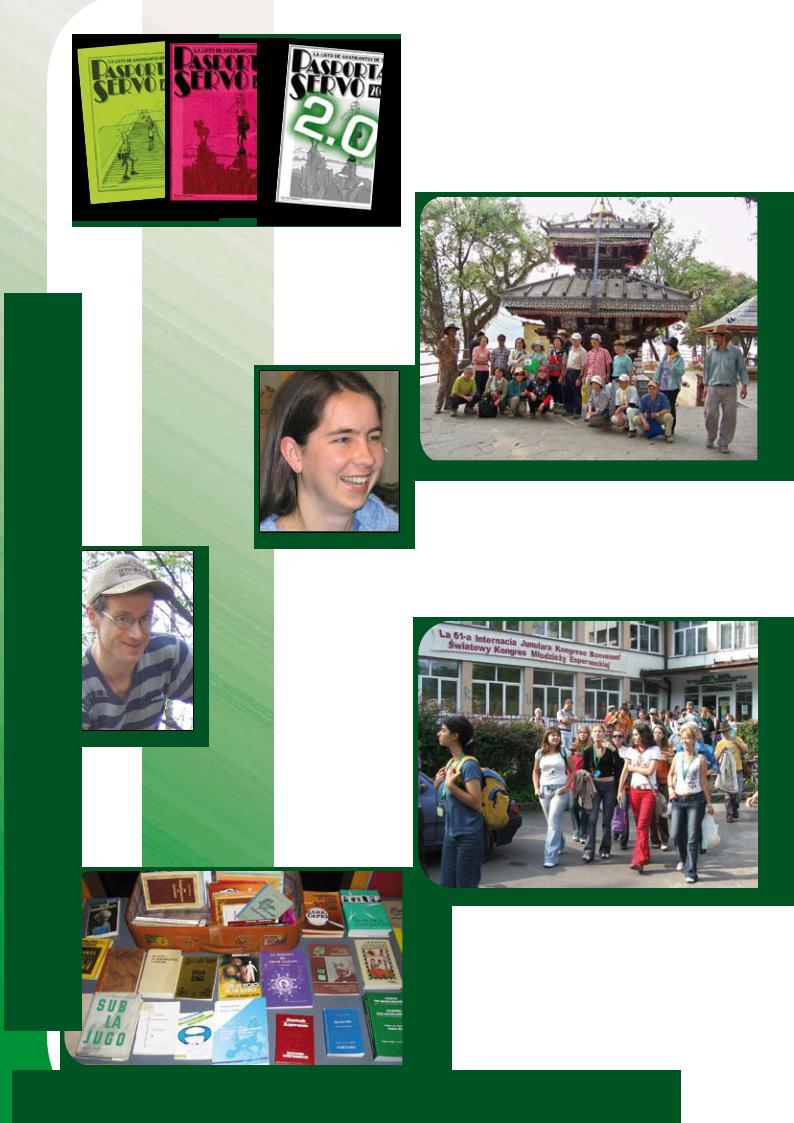
Basic information about Esperanto
4
Another way to use Esperanto is to travel to a foreign country and stay for free in the home of an Esperanto speaker. When you stay with ordinary people in a foreign country, you tend to get a better picture of that country's lifestyle and customs than you would if you stayed in a hotel. Pasporta Servo (Passport Service) is a network of Esperanto speakers who are happy to provide such accommodation. It contains roughly 1200 addresses in more than 90 countries.
Perhaps the most useful aspect of Pasporta Servo is that you don't need to plan a whole lot with it. You can just decide to go where you want, as the mood strikes you.
Amanda Higley, from the USA,
who travelled through Europe for sixteen months and paid for only three nights' lodging.
A third way to use Esperanto is to correspond with speakers by post or on the Internet – a quick and easy way to contact people in other countries.
The Internet removes physical distance, and Esperanto removes 'language distance'. So the Internet and Esperanto make a great pair for international communication!
Henning Sato von Rosen, one of the founders of E@I
Some Esperanto speakers use the language to actively promote a better, more peaceful world. There are those who use it to read news about events in various countries, written by the very people who live in those countries. And others enjoy books that were originally written in a minority language, and that have been translated into Esperanto but not into the reader's mother tongue.
International
Esperanto events
Here are some examples of popular international Esperanto events around the world:
HIMALAYAN MEETING
The Himalayan Meeting has a strong focus on tourism. With local Esperantists as their guides, the participants can learn about Nepalese life and the sights of Nepal. There's usually also a rather longer excursion outside the capital, Kathmandu, during which Esperanto speakers from Nepal and other countries can live together, get to know each other, and practise the language in an exotic environment.
INTERNATIONAL YOUTH CONVENTION – IJK
An excellent event for all young Esperanto enthusiasts. In its lively informal atmosphere, it's easy to make new friends from other countries and get to know the global Esperanto youth movement. Hundreds of people take part, usually from about 30 countries. The convention is held in a different country each year.
DISCOVER ESPERANTO
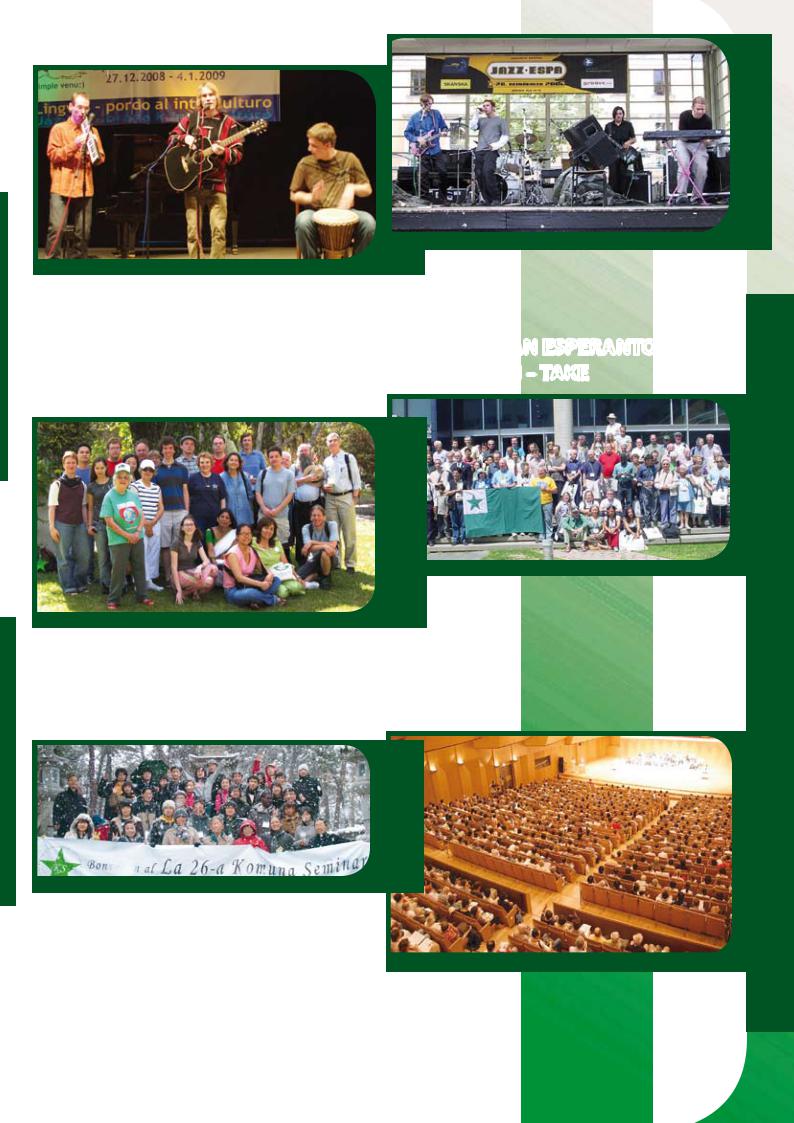
YOUTH ESPERANTO WEEK – JES
|
the afternoons and evenings there are usually plays, lectures, |
|
A fun week of celebrations around New Year, somewhere |
discussions, and concerts by Esperanto musicians. At night |
|
there's dancing, with a bar and a café. The festival is usually |
||
in Europe. There's a serious programme during the day, but |
||
held in Northern Europe. |
||
most people are there to hang out with friends, dance, and |
||
|
enjoy the nightlife. |
ALL-AMERICAN ESPERANTO |
|
|
NORTH AMERICAN SUMMER |
CONVENTION – TAKE |
COURSES – NASK |
|
NASK takes place over three weeks in the summer at a university in the USA, and consists of intensive Esperanto study at various levels of proficiency. Its teaching staff and body of students are international.
COMMON SEMINAR – KS
TAKE's goals are to increase solidarity between the Esperantists of North, Central, and South America, to advance the Esperanto movement, and to study its problems. Along with its work sessions, the convention also has a number of educational and entertainment programmes that introduce participants to the history and culture of the host country.
WORLD CONVENTION – UK
Esperanto about information Basic
A cooperative seminar for young people, mostly from China, |
|
|
|
Japan, and Korea, held in each of those countries in turn. It takes |
|
|
|
place every year, and serves to bring together young Esperanto |
|
|
|
speakers in Asia. |
|
|
|
CULTURAL ESPERANTO |
The Universala Kongreso is the largest annual Esperanto |
|
|
FESTIVAL – KEF |
event, and has a varied programme: mainly lectures and |
|
|
meetings, but also concerts, stage plays, excursions, and |
|
||
A festival with a colourful programme of Esperanto culture |
dancing. There are usually between 2000 and 4000 people |
|
|
in which people of various ages take part. The musicians and |
from around 50 countries there. The event takes place in a |
|
|
artists come mainly – but not exclusively – from Europe. In |
different country each year. |
|
|
|
|
A FASCINATING LANGUAGE |
5 |
|
|
|
|
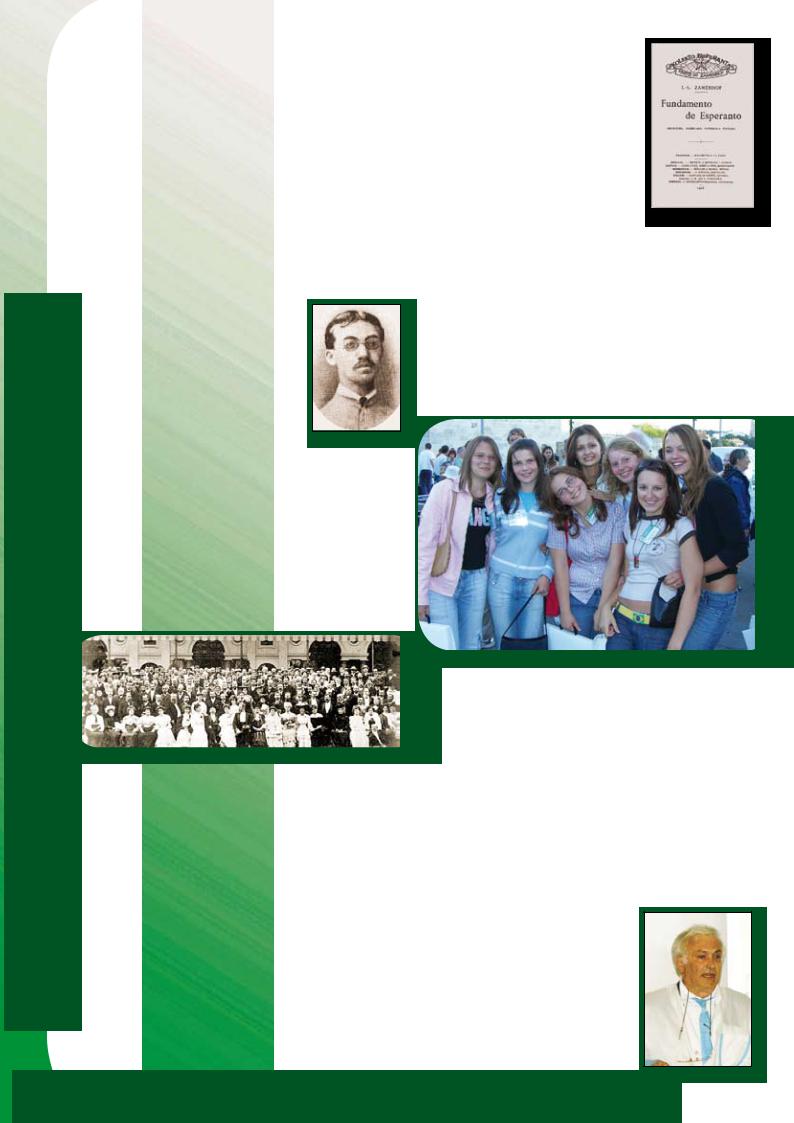
Basic information about Esperanto
6
How did Esperanto become a living language?
It may sound incredible that a one-man project could evolve into a living international language. Nonetheless,that'swhathashappenedwithEsperanto: it now develops in much the same way as other languages. (We know, because we use it every day.)
Here are the main factors that helped Esperanto become a living language:
Zamenhof had a great talent for designing the heart of a language
Zamenhof started pondering the possibility of an international language when he was just a child – and when he became a young man, he decided to bring his ideas to fruition. At the age of 17, he showed the initial result to his school friends. Over the next ten years, he adjusted and refined the
structure, and in 1887, he published it under the name Lingvo Internacia.
People were soon using Esperanto in several countries
Within just a few years of its launch, Esperanto had a community of speakers who used it, appreciated it, and looked after it. Many of them exchanged letters and met up with Esperanto speakers from other countries. As a result, people were using Esperanto for various types of international communication right from the word go.
Esperanto is partly natural and partly constructed
Because Esperanto uses word roots and grammatical concepts from national and ethnic languages, it feels like a natural language when you speak it. At the same time, Esperanto is relatively easy to learn – its grammar has no exceptions, and it derives new words in a sensible way.
These are features of its carefully constructed framework.
The inner idea
–a commonly held (but optional) philosophy
Associated with Esperanto is a philosophy of peace and friendship between all the peoples of the world. This is often referred to as the 'inner idea' ". It's a great inspiration to those who dream of a better, more peaceful future. It's because of the inner idea that many people are happy to devote their energy and spare time to the Esperanto movement.
Zamenhof left the development of Esperanto up to its users
In 1905, at the first major convention of Esperanto speakers, Zamenhof declared that he would no longer control the language's direction. Instead, anyone who used Esperanto could influence its evolution. That decision proved to be a wise one: it made many people feel they had a role to play in the process of developing the language, and so they became more involved.
Esperanto has a stable core that forbids arbitrary changes
To avoid squabbles about alterations to Esperanto, Zamenhof suggested that the language should have a permanent unchanging core, as described in the document Fundamento de Esperanto (Foundation of Esperanto). This proposal was accepted in 1905, and the Fundamento continues to have a stabilizing effect on the language as it evolves today.
DISCOVER ESPERANTO
Esperanto is not just a European language
Esperanto uses European languages as the basis for its vocabulary, but its grammar and word-building system resemble Chinese, Turkish, and other non-Indo-European languages in several ways. Syntax and style in Esperanto are
largely Slavic. People learn Esperanto in just a few months or a few years, regardless of their mother tongue, and they end up feeling fully at home in it.
The established community of Esperanto speakers all around the world today is proof that Esperanto has indeed become a living international language. Most speakers learn it when they're teens or adults, but there are also those people who grew up in an Esperanto family and so speak
it as one of their native languages.
I have the abiding belief that Esperanto is the most valuable thing I inherited from my dear parents.
Carlo Minnaja from Italy, who spoke Esperanto at home with his parents and brother.
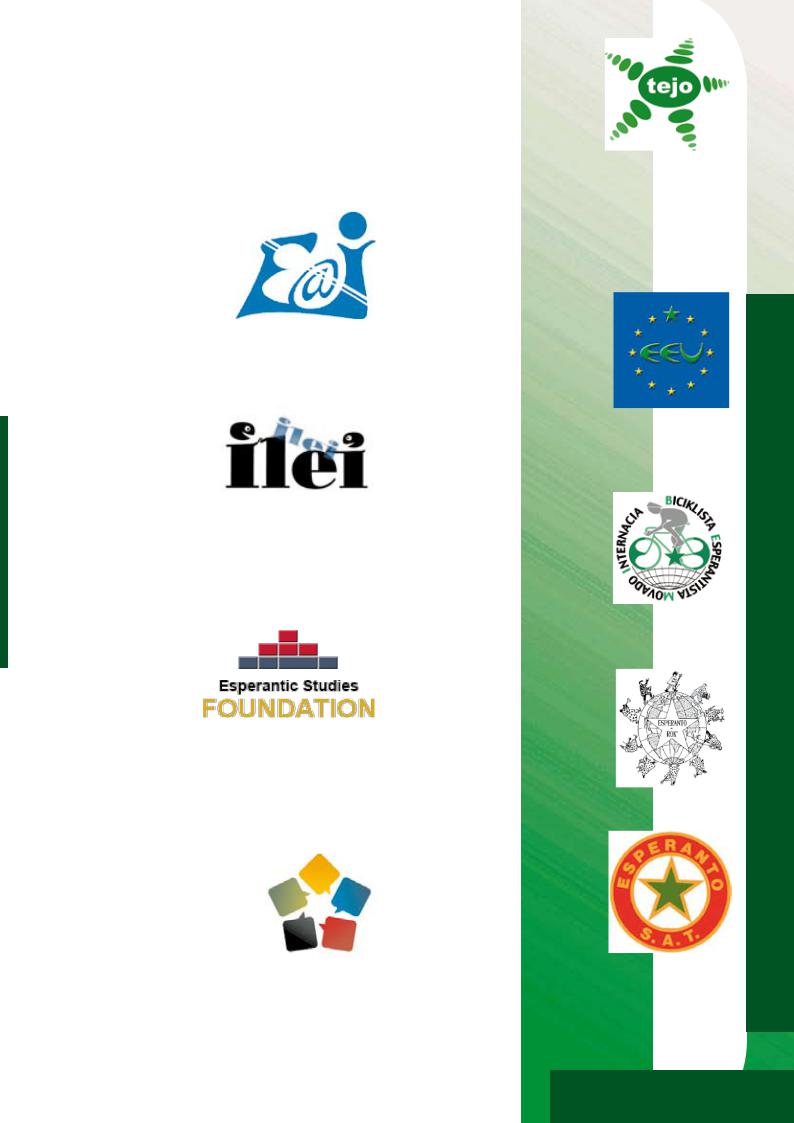
International Esperanto organizations
There are a number of international Esperanto organizations that make it easier for speakers to coordinate their activities at a global level.
Here's a quick introduction to some of them.
Education@Internet – E@I
E@I is an international work group that promotes worldwide collaboration and communication. The group arranges educational projects and events to support cross-cultural studies alongside
the use of languages and Internet techniques. An example of a successful E@I project is www.lernu.net (a multilingual website for learning Esperanto). Home page (multilingual): www.ikso.net
International League of Esperanto Teachers – ILEI
ILEI is the main gathering
place for Esperanto teachers and educators. The organization has branches in over 30 countries and members in more than 45. ILEI's activities include teaching Esperanto in schools and universities, and arranging exams that test people's knowledge of Esperanto language and culture. Home page (in Esperanto): www.ilei.info
Esperantic Studies
Foundation – ESF
ESF supports the research and teaching of Esperanto and related topics in the
framework of interlinguistic communication, especially at university level in North America. It runs various projects that explore its central question: is it possible to have a world in which many languages, large and small, coexist in relative equality, and where communication on a global scale is accessible to rich and poor alike? Home page (in English): www. esperantic.org
World Esperanto
Association – UEA
UEA was founded in 1908 as an organization for individual Esperanto speakers. At present, it's the largest
international association of Esperantists, with members in 117 countries. UEA not only spreads the word about Esperanto, it also works to promote discussion of the world's language problems and to draw attention to the need for equality among languages. Home page (multilingual): www.uea.org
World Esperanto Youth Organization
– TEJO
TEJO is an international nongovernmental youth organization that was founded in 1938. Through
Esperanto, it promotes peace and cross-cultural understanding among young people around the world. TEJO is actively engaged with the problems and concerns of young people today, especially regarding matters of language and culture. From its central office in the Netherlands, it coordinates the work of over 40 national branches and of members in more than 80 countries. Home page (multilingual): www.ikso.net. Home page (multilingual): www.tejo.org
European Esperanto Union – EEU
EEU fights for language equality and diversity in Europe. It regards equality as an essential part of true democracy, and considers language diversity to be
as important as the diversity of animals and plants in ecology. Furthermore, EEU favours developing a European identity that would peacefully coexist with national and regional identities. Home page (in Esperanto): www.europo.eu
International Association of Esperanto-speaking Cyclists – BEMI
This is one for people who like to ride their bike while speaking Esperanto!
BEMI organizes various regular bicycle convoys, often in connection with youth events. Home page (multilingual): bemi.free.fr
Eurokka
Eurokka operates worldwide, both inside and outside the Esperanto movement, spreading and encouraging Esperanto's musical culture, and promoting bands and artists who
perform in Esperanto. Home page (in Esperanto): artista.ikso. net/eurokka
World Non-National Association – SAT
SAT's main aim is education through Esperanto, particularly for the working class. For SAT, Esperanto is a tool, not a goal. The organization has a general
socialist character, but it welcomes any socialist faction that accepts the principle of free and open debate. The word "nonnational" means that, unlike the majority of the international workers' movement, SAT's members are not affiliated to regional or national branches. Home page (multilingual): www. satesperanto.org
Esperanto about information Basic
A FASCINATING LANGUAGE 7
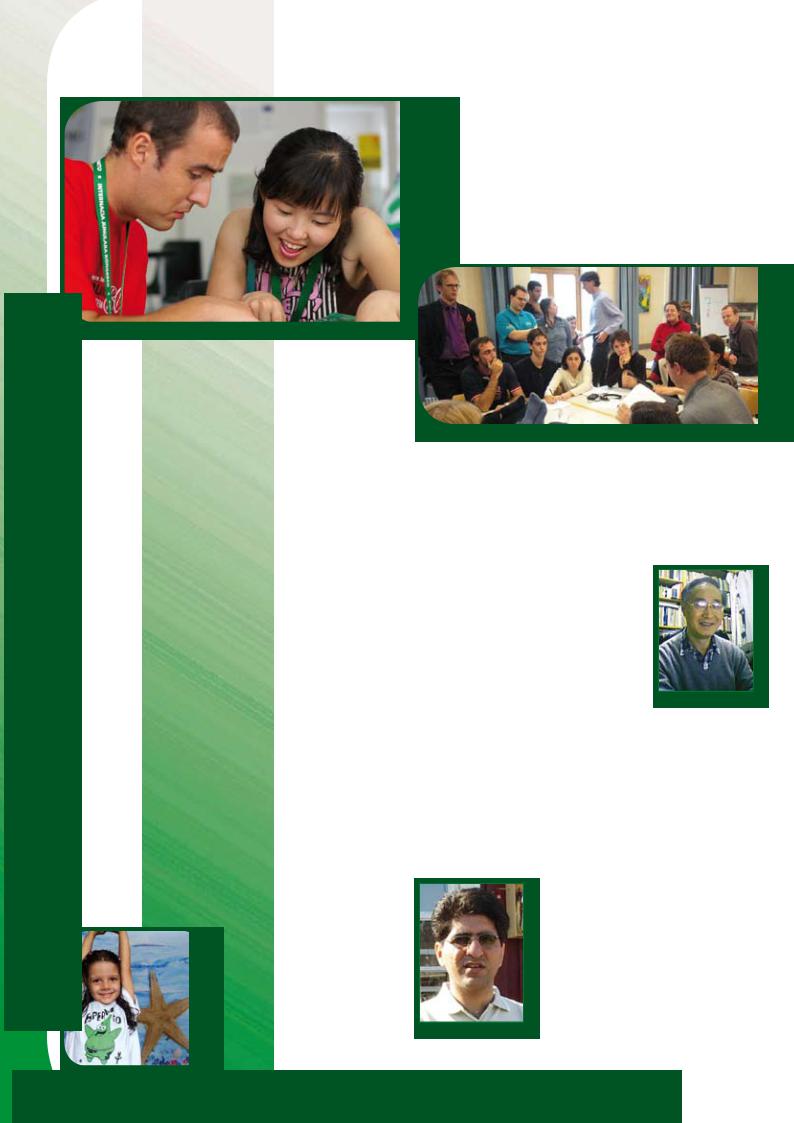
Basic information about Esperanto
Suitable for international communication
While you've been reading this booklet, you may have thought:
"Esperanto, an international language? But we already have an international language. English is the world's international language, and almost everyone can speak it."
You're quite right that English is the language most commonly used in international situations. Around 7% of people speak English as their mother tongue, and by various estimates, another 7% or so learn English to a high standard as teens or adults. But people who acquire great proficiency in English are generally those whose native languages resemble English, such as Germans, Dutch, and Swedes. For many others – Hungarians, Chinese, Turks, and Koreans, for example – whose mother tongues are very different from English, it's often extremely tricky and time-consuming to learn English to a high standard.
Lots of other languages are also used as bridges for communication in localized areas. There are many possible approaches to international communication. We believe that multilingualism deserves strong support, and the work of the Esperanto movement also supports the use of smaller or minority languages in various contexts. But bear in mind that not everyone is good at learning foreign languages, and that not everyone wants to spend their spare time learning several different ones. In particular, there are people who would like to learn to speak a foreign language, but were unable to achieve this at school: for them, Esperanto can be an interesting alternative.
Inourexperience,Esperantoiswellsuitedforinternational communication. Here are some of the reasons why:
1) Easier
To anyone who has learned both Esperanto and a national or ethnic language as a foreign language, it's clear that Esperanto was the easier one to learn. Esperanto is a relatively easy language because there are only a few rules, and they don't have any exceptions. Furthermore, there's less vocabulary to memorize: you can easily build new words by combining roots, prefixes, and suffixes. We can't tell you
exactly how much easier Esperanto is to learn than other languages: it varies, depending on which language you compare it with, and on the desired level of proficiency. But people generally learn Esperanto in a fifth to a third of the time they would need if they wanted to reach the same standard in other languages.
2) Less biased
Esperanto doesn't belong to any particular nation or people. This makes it less biased than national or ethnic languages when it comes to global communication. Esperanto is not tied to any specific nation or ethnic culture, and that's a great advantage for a language that serves as a bridge between the various peoples of the world. (This doesn't mean that Esperanto is a language with no culture: in fact it has an international culture all of its own.)
3) Fairer
There's a good chance that anyone who learns Esperanto will reach a high level of proficiency in it, and then be able to communicate on an equal linguistic footing with others, regardless of their language
background. This is the case for everyone, not just Westerners. It's generally true that speakers who learned Esperanto as a mother tongue don't speak the language any better than anyone else: anyone who studies Esperanto seriously can reach the same high standard as a native speaker. That's why, for global communication, Esperanto is fairer than the national languages – while a few people seem to master these effortlessly, most of us have to struggle for years to speak them well.
In my opinion, Chinese people learn Esperanto far more easily than European languages. In addition, Chinese who've learned Esperanto have a huge advantage over others when they study European languages.
Xiao Peiliang, China
Esperanto can be of great interest to anyone who feels it's important that an international language should be easy, neutral, and fair.
English is currently the most widely used language for global communication. But who knows? At some point in the future, more and more people may discover how well suited Esperanto is to the job of international communication, and then both English and Esperanto will serve in parallel as major international languages. That would mean a great deal to the millions of people who find it very hard to become proficient in English.
I'm an Iranian student, studying in Paris for a doctorate in science. I've always used English in my studies, and since arriving in France, I've begun learning French. I've learned Esperanto as well, and I must confess it's the only language
– apart from my native one – in which I feel comfortable. I don't feel at home in any other foreign language. In my opinion, Esperanto is suitable for everyone,
including people from Asia. |
Behrouz Soroushian, Iran |
8 DISCOVER ESPERANTO

Esperanto culture
Esperanto has songs, films, poems, novels, short stories, magazines, plays, cabarets, folk music, rock music, pop music, rap music, and much more besides. SoEsperantodefinitelyhasculture.(Theworld"culture" can include a lot more than just these things, but this is a short booklet and we have to limit ourselves.)
There were poems even in the very first Esperanto booklet. Right from the start, people noticed that Esperanto had a richness and beauty that lent itself well to creative writing. After all, it's a language that feels liberating, partly
because of its relatively free word order and its ability to create new words using prefixes and suffixes.
I discovered how amazing the language is for writing lyrics, and I wanted to continue for the sheer pleasure of writing in the language.
Martin Wiese,
singer in the Esperanto bands Persone and Martin & la talpoj
Every year sees the publication of lots of new books in Esperanto.
Every year also sees the release of new Esperanto songs, and of CDs by artists in various genres. You can find Esperanto radio programmes and podcasts online. There are regular cultural festivals where people can enjoy various aspects of Esperanto culture. If you would like to listen to some Esperanto songs, go to www.vinilkosmo.com.
Singing in Esperanto is like singing in Portuguese, and it's more fun than singing in English.
Rogener Pavinski, from Brazil, singer with the rock group Supernova
Esperanto also serves as a bridge between national or ethnic cultures. One example of this is the thousands of books that have been translated into Esperanto from national or ethnic languages. They include the great classics, as well as more obscure "pearls of literature" written in minority language.
There are plenty of Esperanto magazines, with various subjects and audiences. Two of them are Monato and Beletra Almanako:
Monato (Month) is a monthly magazine about world events, major and minor. Its selling point is that its articles are not written by foreign correspondents (who seldom have really deep knowledge or understanding of local society) but by the very people who live in those
countries and have directly experienced the events they describe.
BeletraAlmanako(Literary Almanac) is a literary journal containing original and translated poetry and prose (fiction and non-fiction), essays, reviews, drama, and so on.
Take note!
The Esperanto community strongly supports the concepts of language diversity and language rights. All languages are valuable, and it's important that the majority languages do not push local and minority languages out of use.
Learning Esperanto is good preparation for learning other languages quickly and easily, whether you're a child or an adult. What's more, people who learn Esperanto often develop an interest in learning additional languages.
Esperanto is not perfect. It's not perfectly neutral, nor is it perfectly fair. But in our experience, it's a fairer and less biased way of communicating internationally than using a national language.
Esperanto is not a national language: its purpose or role is not the same. So to decide if it's a good language, we shouldn't ask how well it can duplicate what national languages do. Rather, we should judge it on how well it plays its own role – that of a bridge between ethnic groups. From La Bona Lingvo
(The Good Language) by Claude Piron
Esperanto about information Basic
A FASCINATING LANGUAGE 9

Introducing the Esperanto language
10
Introducing the Esperanto language
This is a brief description of how Esperanto works. We don't have enough space here to describe the entire language, so we'll just look at the alphabet and the way words are formed. (For a detailed description of Esperanto grammar, as well as courses, exercises, and dictionaries, we recommend the multilingual website www.lernu.net.)
Alphabet and pronunciation
Esperanto has 28 letters, five of which are vowels:
a b c ĉ d e f g ĝ h ĥ i j ĵ k l m n o p r s ŝ t u ŭ v z
Helpfully enough, each letter has much the same sound regardless of the word it appears in, and the spelling of every word matches its pronunciation. This means that if you know how to pronounce a word, you also know how to spell it. All words are stressed on the second- to-last syllable, as in: hUndo, internacIa, flOro.
Words
Esperanto'svocabularyisdrawnfromseverallanguage families: about 75% of the roots are from Romance, about 20% are from Germanic, and about 5% come from other groups. Zamenhof tried to choose roots that are well-known to speakers of the main European languages. Here are some examples:
from Latin: sed (but), tamen (however), okulo (eye), akvo (water)
from French: dimanĉo (Sunday), fermi (to close), ĉevalo (horse), butiko (shop, store)
from Italian: ĉielo (sky), fari (to do), voĉo (voice)
from various Romance language: facila (easy), fero (iron), tra (through), verda (green)
from German: baldaŭ (soon), bedaŭri (to regret), jaro (year), nur (only)
from English: birdo (bird), suno (sun), ŝarko (shark), teamo (team)
from various Germanic languages: bildo (picture), fremda
(foreign), halti (to stop), ofta (frequent)
In Esperanto, a lot of words are more than just roots: they are compounds. For example, there's no root for the word "knife". Instead, the root tranĉ- (cut) is combined with the suffix -il- (denoting a tool) and the ending -o (indicating a noun) to produce tranĉilo "knife". Other examples with the -il- suffix are: tondilo (scissors), ŝraŭbilo (screwdriver), skribilo (writing implement), retumilo (web browser), ludilo (toy).
Word endings
An interesting aspect of Esperanto is that there are certain endings that apply equally well to any root.
For example, if we take the root somer- and add -o – the ending for nouns – we get somero (summer). But if we add -a – the adjective ending – then the word becomes somera (summery, relating to summer). And if we add the adverb ending -e, we get somere (in the summer, at summertime). The ending -j marks the plural: someroj (summers).
En Italio estas varmaj someroj. – In Italy, summers are hot. Somere mi ŝatas bicikli. – In the summer I enjoy cycling. Kia bela somera robo. – What a lovely summer dress.
-o for nouns: Nouns are names for people and things. A noun answers the question: "What is it?" Examples: homo (a person), ideo (an idea), nomo (a name), domo (a house).
-a for adjectives: Adjectives describe nouns. An adjective answers the question: "What's it like?" Examples: bela (beautiful), bona (good), longa (long), varma (hot), interesa (interesting).
-e for adverbs: Adverbs describe verbs, adjectives, other adverbs, or entire sentences. Examples: bele (beautifully), longe (for a long time), bone (well), interese (interestingly). (There are also a few very basic adverbs that don't end in -e.)
-j for plurals: Plural means there's more than one. Examples: homoj (people), ideoj (ideas), grandaj domoj (large houses), varmaj someroj (hot summers).
-n for the object: The object of a sentence is the thing that's directly affected by the action. For example, in the sentence Ŝi amas lin (She loves him), lin (him) is the object.
-i, -is, -as, -os, -us, -u for verbs: The endings used with verbs are:
-i for the infinitive, e.g. vidi (to see), kanti (to sing), ridi (to laugh)
-is for the past tense, e.g. vidis (saw), kantis (sang), ridis (laughed)
-as for the present tense, e.g. vidas (sees), kantas (sings), ridas (laughs)
-os for the future tense, e.g. vidos (will see), kantos (will sing), ridos (will laugh)
-us for the conditional, e.g. vidus (would see), kantus (would sing), ridus (would laugh)
-u for commands, e.g. vidu (see!), kantu (sing!), ridu (laugh!)
These endings are the same for all verbs – which means there are no irregular verbs in Esperanto. What a relief!
DISCOVER ESPERANTO
